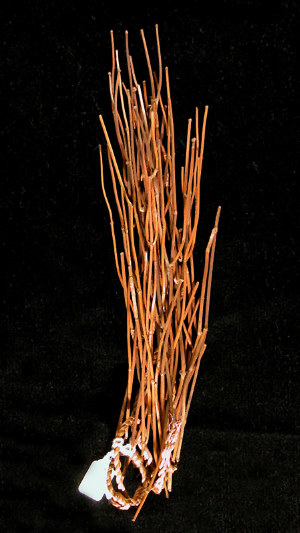Mormon Tea
Boundary Ephedra, Joint-fir (Ephedra aspera Engelmann)
Clapweed, Popote,
Vine Ephedra (Ephedra antisyphilitica Berl. Ex C.A. Mey.)
Ephedraceae (Ephedra Family)
Ephedra, commonly known as Mormon tea, is a small bushy or vine-like dioecious shrub with naked, jointed green to yellow-green stems. The term "naked" refers to the plant's appearance of having no leaves, but the leaves are actually scale-like and attached to the joints. Morman tea is widely scattered across the entire Lower Pecos region; dense stands occur just west of Langtry. Ephedra was used by native groups as medicine, often prepared as a tea.
Archeological occurrence. A large fragment of an ephedra plant with multiple stems in the Witte Museum collections was recovered from the Shumla Caves. Exact provenience was not recorded. Ephedra pollen in elevated percentages (15%) was recovered from a coprolite from Baker Cave (Sobolik 1991:46). When more collections from Baker Cave and other Lower Pecos rockshelters are analyzed, more ephedra is bound to be identified.
Beverages, medicine and ritual. Ephedra contains alkaloids, including ephedrine and pseudoephedrine, both of which dilate nasal passages and raise the heart rate, a sort of good and bad reaction. They are considered to be drugs that enhance performance and are banned by most sports organizations. Native Americans recognized the medicinal qualities of the plant and applied it to many diseases.
Several groups utilized ephedra as a beverage and made a tea from it. These groups included the Papago, Pima, Cahuilla, White Mountain Apache, Havasupai, Kawaiisu, and Zuni (Castetter and Underhill: 1935; Russell 1908; Bean and Saubel 1972; Reagan 1928; Weber and Seaman 1985; Zigmond 1981; and Stevenson 1915).
Ephedra was used as a treatment for diarrhea by the Tewa (Robbins et al. 1916). The White Mountain Apache used ephedra to treat gonorrhea and syphilis. An informant related that consumption of ephedra caused the urine to turn a milky color. The Navajo also used ephedra tea to treat venereal disease (Reagan 1928:157). The Cahuilla believe that ephedra tea purifies the system, but that it should not be taken continually (Bean and Saubel 1972:70). Most of the aforementioned groups treated syphilis using ephedra.
The value of the plant was also known to ranchers in the Lower Pecos Canyonlands. Perry Calk, who was raised on land just below the Pecos River high bridge north of Comstock, had to drink a tea that his mother made from ephedra every spring. During that time of the year, his mother would gather large quantities of the plant, steep it in hot water, and have the children drink it as a "health drink" (Perry Calk, personal communication 2004).
Zigmond (1981), perhaps, reports the oddest use of ephedra. The Kawaiisu favored the use of charred ephedra wood for tattooing. Ephedra wood has wide radially projecting rays and is usually hollow in the middle and very irregular in shape. When charred, it breaks into small stick shaped portions, and this may be why it was considered convenient for tattooing.
References:
Bean, Lowell J. and Katherine S. Saubel
1972 Temalpakh: Cahuilla Indian Knowledge and Usage of Plants. Malki Museum Press, Morongo Indian Reservation, Banning, California.
Castetter Edward F. and Ruth Underhill
1935 The Ethnobiology of the Papago Indians. Ethnobiological Studies in the American Southwest. Vol. II. The University of New Mexico Bulletin, Biological Series 4(3), Albuquerque.
Reagan, Albert D.
1928 Plants Used by the White Mountain Apache Indians of Arizona. The Wisconsin Archeologist 8:143-161.
Robbins, William W., John P. Harrington, and Barbara Freire-Marreco
1916 Ethnobotany of the Tewa Indians. Bureau of American Ethnology Bulletin 55, Smithsonian Institution, Washington, D.C.
Russell, Frank
1908 The Pima Indians. In Twenty-sixth Annual Report of the Bureau of American Ethnology, No. 26. [1904-1905], pp. 17-389, Washington, D.C.
Sobolik, Kristin D.
1991 Prehistoric Diet and Subsistence in the Lower Pecos as Reflected in Coprolites from Baker Cave, Val Verde County, Texas. Studies in Archeology 7, Texas Archeological Research Laboratory, University of Texas at Austin.
Stevenson, Matilda Coxe
1915 Ethnobotany of the Zuni Indians. Thirtieth Annual Report of the Bureau of American Ethnology, [1908-1909], pp. 35-103, Washington, D.C.
Weber, Steven A. and P. David Seaman
1985 Havasupai Habitat: A.F. Whiting's Ethnography of a Traditional Indian Culture. University of Arizona Press, Tucson.
Zigmond, Maurice L.
1981 Kawaiisu Ethnobotany. University of Utah Press, Salt Lake City.
![]()
